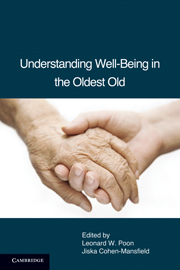Book contents
- Frontmatter
- Contents
- List of Tables
- List of Contributors
- Foreword by Carol D. Ryff
- PART I THEORY: NEW HORIZONS IN WELL-BEING RESEARCH
- PART II PARADISE LOST: BETWEEN TRAUMA AND HAPPINESS
- PART III PATHWAYS AND GATEKEEPERS: MODERATING, MEDIATING, AND PROXIMAL PROCESSES
- PART IV SIGNPOSTING PARADISE: MEASUREMENT OF WELL-BEING
- 15 Culture and Meaning: Strategies for Understanding the Well-Being of the Oldest Old
- 16 The Will to Live as an Indicator of Well-Being and Predictor of Survival in Old Age
- 17 The Measurement of Life Satisfaction and Happiness in Old-Old Age
- 18 Late-Life Psychotherapy: Challenges and Opportunities to Enhance Well-Being in the Oldest Old
- 19 An Integrative Summary and Future Directions in the Study of Well-Being
- Index
- References
18 - Late-Life Psychotherapy: Challenges and Opportunities to Enhance Well-Being in the Oldest Old
Published online by Cambridge University Press: 05 August 2012
- Frontmatter
- Contents
- List of Tables
- List of Contributors
- Foreword by Carol D. Ryff
- PART I THEORY: NEW HORIZONS IN WELL-BEING RESEARCH
- PART II PARADISE LOST: BETWEEN TRAUMA AND HAPPINESS
- PART III PATHWAYS AND GATEKEEPERS: MODERATING, MEDIATING, AND PROXIMAL PROCESSES
- PART IV SIGNPOSTING PARADISE: MEASUREMENT OF WELL-BEING
- 15 Culture and Meaning: Strategies for Understanding the Well-Being of the Oldest Old
- 16 The Will to Live as an Indicator of Well-Being and Predictor of Survival in Old Age
- 17 The Measurement of Life Satisfaction and Happiness in Old-Old Age
- 18 Late-Life Psychotherapy: Challenges and Opportunities to Enhance Well-Being in the Oldest Old
- 19 An Integrative Summary and Future Directions in the Study of Well-Being
- Index
- References
Summary
ABSTRACT
This chapter discusses problems with psychosocial treatments for the oldest old. We attempt to straddle the tenets of the Developmental Adaptation and Changes of Adaptation models as well as the offerings in other chapters. We highlight how the distal and proximate variables noted in the previous chapters are necessary but not sufficient for the eventual understanding of treatment outcomes in the oldest old. To date, the psychosocial adjustment and treatment of the oldest old have been largely ignored, having been given short shrift as a result of the medical model. The present chapter considers the biopsychosocial model as it applies to this developmental stage – issues, problems, strengths, and future directions. Given inherent biological limits, we specify the role of a life lived, one's life history, and how this might influence current stress and well-being. Finally, we discuss treatment models for other age groups and their applicability to empirically supported principles for oldest-old adults.
INTRODUCTION
In our chapter on posttraumatic stress disorder (PTSD), we argued that the trauma response is fundamentally a diathesis-stress response. The role of aging as a largely moderating influence in the expression of psychological trauma was construed as somewhat distinct, especially for the oldest old. Trauma itself is multidimensional and mixes with age, a variable that owns both positive and negative features as it relates to health and well-being. In that chapter, treatment required a focus on the “person” of the victim of trauma.
- Type
- Chapter
- Information
- Understanding Well-Being in the Oldest Old , pp. 332 - 363Publisher: Cambridge University PressPrint publication year: 2011
References
- 1
- Cited by

